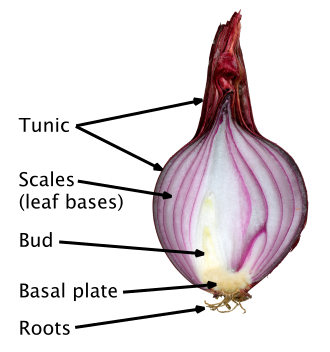Bulb
Bulb refers to a specialized underground storage organ present in some plant species used for storing nutrient reserves to survive winter or other adverse conditions. Bulbs are a type of perennation organ, which also includes tubers, corms, and rhizomes. They are primarily found in the family Liliaceae, but are also seen in several other families of monocots and a few dicots. Bulbs enable plants to survive in harsh environmental conditions by going into a period of dormancy.
Structure
A bulb's structure typically consists of a short stem at the base, surrounded by fleshy leaf scales which are essentially modified leaves that store food and nutrients. These scales are sometimes referred to as bulb scales. In some species, a bulb may also have a protective outer layer called a tunic, which helps to protect it from physical damage and water loss. Bulbs that lack a tunic are described as naked bulbs.
Types of Bulbs
Bulbs can be classified into two main types based on their structure:
1. True Bulbs: These have layers of fleshy scales with a basal plate at the bottom and a growing point or shoot at the top. Examples include onions (Allium cepa) and daffodils (Narcissus).
2. Imbricate Bulbs: These are also true bulbs but lack the protective tunic, making them more susceptible to damage. An example is the lily (Lilium).
Function
The primary function of a bulb is to store energy in the form of carbohydrates to support the plant's growth and flowering in the next growing season. This energy reserve is crucial for the plant's survival during unfavorable conditions such as winter or drought.
Propagation
Bulbs reproduce both sexually, through the production of seeds, and asexually, through the formation of new bulbs. Asexual reproduction can occur in various ways, including the division of the bulb into smaller bulbs (bulblets) or the production of new bulbs from the basal plate, a process known as vegetative reproduction.
Cultivation
Bulbs are popular in horticulture and gardening for their ability to produce colorful flowers year after year with minimal care. They are typically planted in the fall to ensure a display of flowers in the spring. The depth and spacing of planting depend on the type of bulb and the specific requirements of the plant species.
Economic Importance
Several bulbous plants are of significant economic importance. For example, the onion (Allium cepa) is a widely cultivated vegetable crop. Other bulbs, such as the tulip (Tulipa) and hyacinth (Hyacinthus), are important in the floriculture industry for the production of cut flowers and ornamental plants.
Conservation
Some bulbous plant species are threatened by over-collection and habitat destruction. Conservation efforts are necessary to ensure the survival of these species in their natural habitats.
Transform your life with W8MD's budget GLP-1 injections from $125.
W8MD offers a medical weight loss program to lose weight in Philadelphia. Our physician-supervised medical weight loss provides:
- Most insurances accepted or discounted self-pay rates. We will obtain insurance prior authorizations if needed.
- Generic GLP1 weight loss injections from $125 for the starting dose.
- Also offer prescription weight loss medications including Phentermine, Qsymia, Diethylpropion, Contrave etc.
NYC weight loss doctor appointments
Start your NYC weight loss journey today at our NYC medical weight loss and Philadelphia medical weight loss clinics.
- Call 718-946-5500 to lose weight in NYC or for medical weight loss in Philadelphia 215-676-2334.
- Tags:NYC medical weight loss, Philadelphia lose weight Zepbound NYC, Budget GLP1 weight loss injections, Wegovy Philadelphia, Wegovy NYC, Philadelphia medical weight loss, Brookly weight loss and Wegovy NYC
|
WikiMD's Wellness Encyclopedia |
| Let Food Be Thy Medicine Medicine Thy Food - Hippocrates |
Medical Disclaimer: WikiMD is not a substitute for professional medical advice. The information on WikiMD is provided as an information resource only, may be incorrect, outdated or misleading, and is not to be used or relied on for any diagnostic or treatment purposes. Please consult your health care provider before making any healthcare decisions or for guidance about a specific medical condition. WikiMD expressly disclaims responsibility, and shall have no liability, for any damages, loss, injury, or liability whatsoever suffered as a result of your reliance on the information contained in this site. By visiting this site you agree to the foregoing terms and conditions, which may from time to time be changed or supplemented by WikiMD. If you do not agree to the foregoing terms and conditions, you should not enter or use this site. See full disclaimer.
Credits:Most images are courtesy of Wikimedia commons, and templates, categories Wikipedia, licensed under CC BY SA or similar.
Contributors: Prab R. Tumpati, MD





